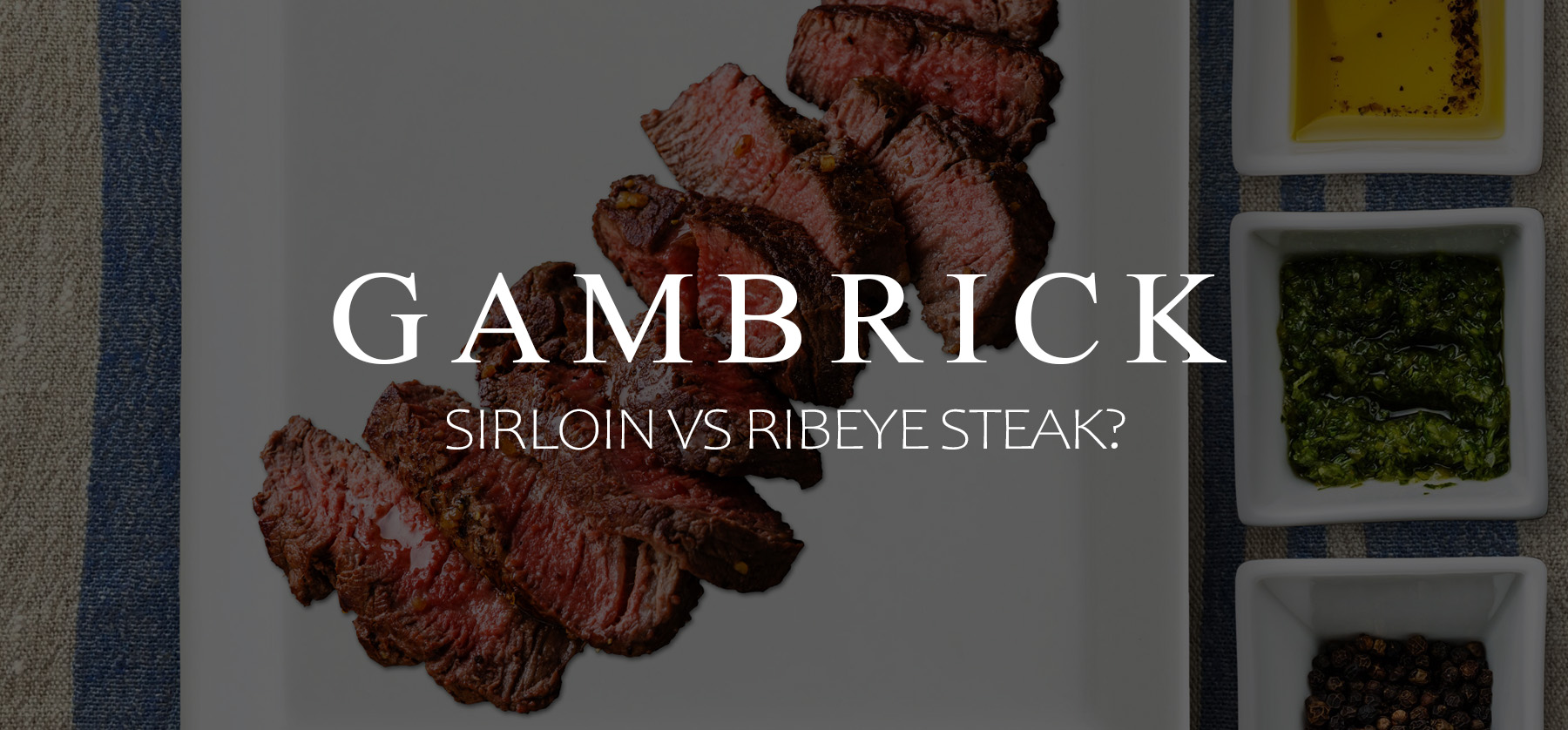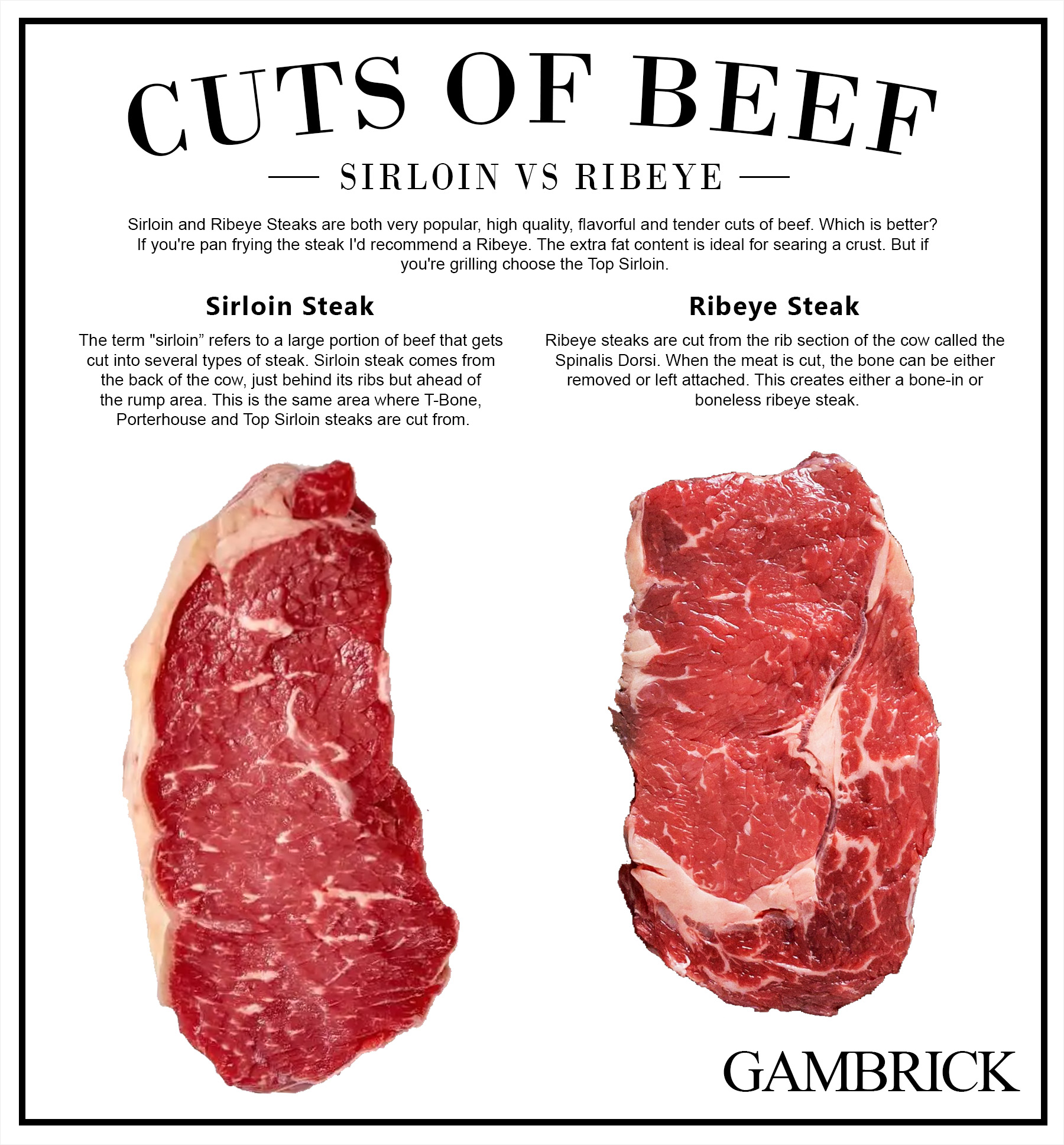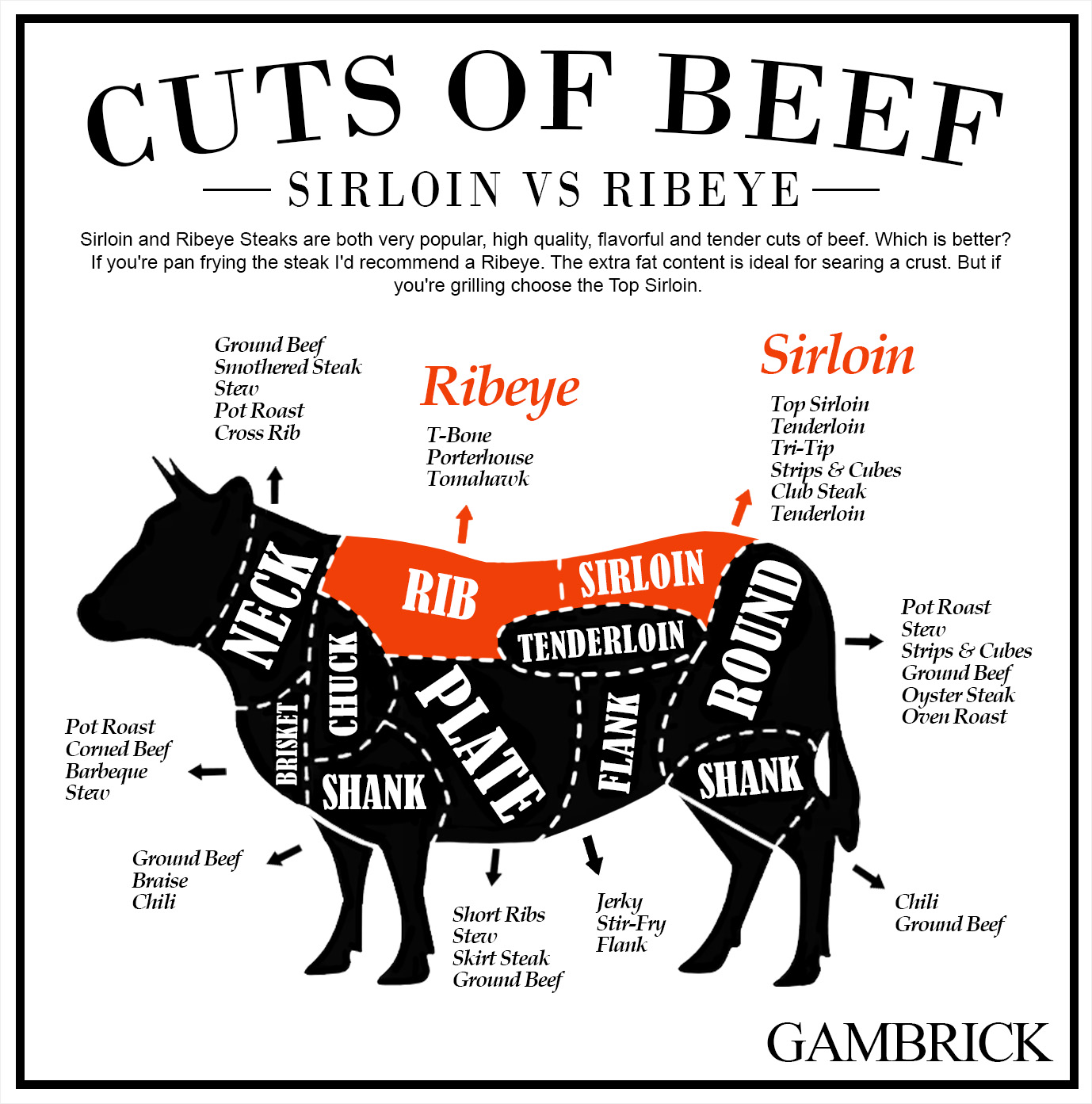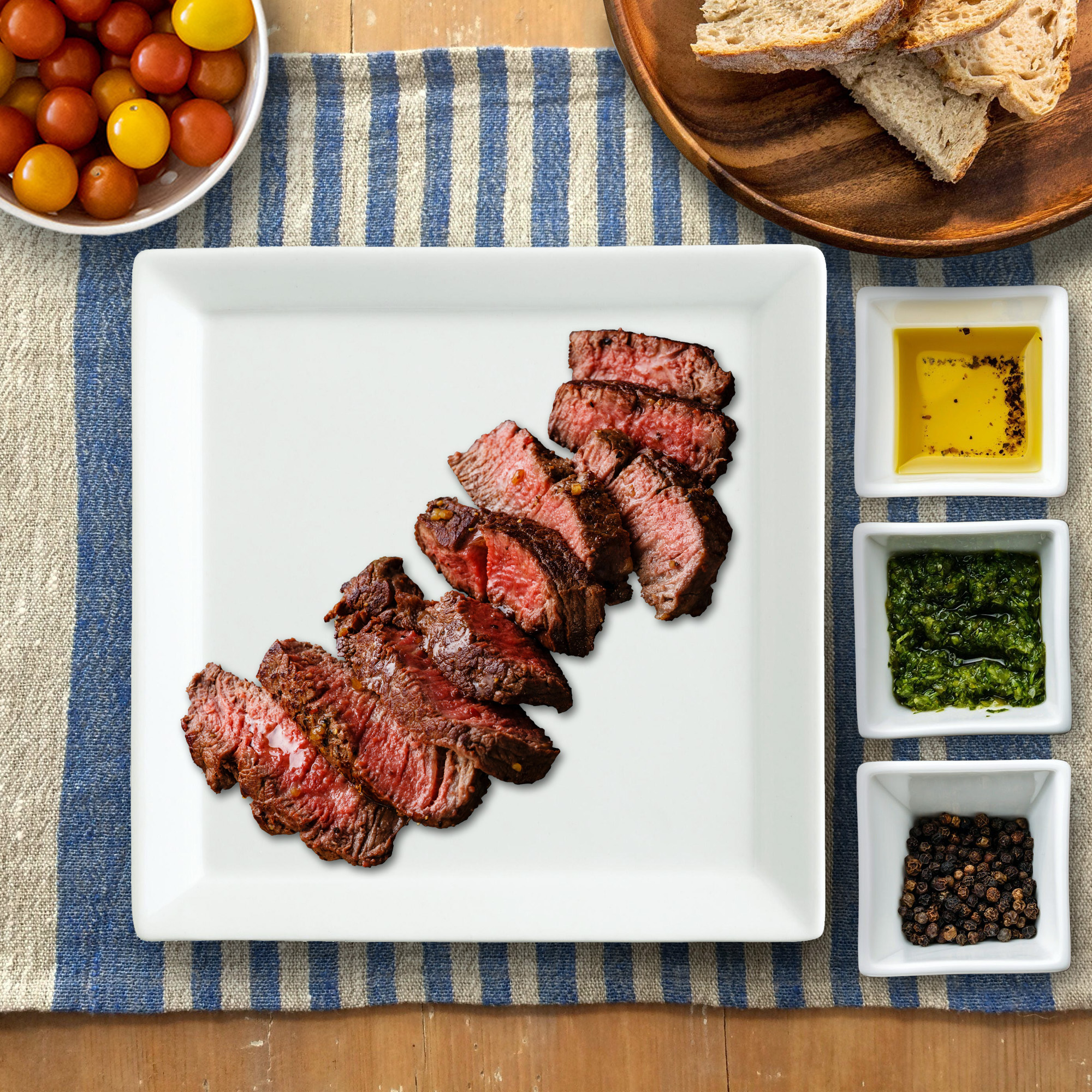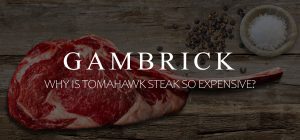Sirloin Vs Ribeye Steak
Sirloin and Ribeye Steaks are both very popular, high quality, flavorful and tender cuts of beef. They have a lot of similarities which is why steak eaters compare and often confuse the two.
Ribeye steaks are cut from the rib section of the cow called the Spinalis Dorsi. When the meat is cut, the bone can be either removed or left attached. This creates either a bone-in or boneless ribeye steak. The area around the bone is fatty and the meat has lots of marbling, which makes Ribeyes a fattier cut than most other steaks. But it also provides tons of rich beefy flavor which is more intense than other cuts like sirloin. Because of all the fat, Ribeye is one of the best steaks for pan-searing. Its fat caramelizes in the pan and develops a beautiful crust.
Sirloin steaks come from the back of the cow, behind its ribs but ahead of the rump. This is the same area where T-Bone, Porterhouse and Top Sirloin steaks are cut from. Sirloin steaks are leaner than Ribeyes which makes them better for grilling. They have a great beefy flavor, although not as rich as Ribeye, and are very tender.
Sirloin steak come from a larger area of the cow than Ribeye so there’s more variation in fat content and quality. For example, Top Sirloin is a better cut of meat than Tri-tip, but they’re both technically Sirloin Steaks. When you compare Ribeye Steak vs Sirloin Steak, make sure the meat is of equal quality. Ribeye is a premium cut of meat so the best comparison would be a Top Sirloin.
Which is better? If you’re pan frying the steak I’d recommend a Ribeye. The extra fat content is ideal for searing a crust. But if you’re grilling choose the Top Sirloin.
What’s A Ribeye Steak?
Ribeye steaks are cut from the rib cage area of the cow called the longissimus dorsi muscle. When the meat is cut, the bone can be either removed or left attached. This creates either a bone-in or boneless ribeye steak.
When the rib bone is removed some of the fat is left behind. This fat strip makes ribeye steaks fattier than many other cuts of beef. But the fat provides loads of flavor and makes ribeye a great steak for pan frying.
- A ribeye’s taste is usually richer than other cuts like sirloin.
- Ribeye is one of the best steaks for pan-searing because of its fat. The fat caramelizes in the pan which develops a beautiful crust.
- Ribeye steaks are one of the most popular cuts ordered at a steakhouse.
- One of the most well marbled steaks.
- Very tender and juicy.
In addition to the fat strip, ribeye steaks have great marbling. Marbled fat are all those thin, white strips that run through each piece of beef ribeye. This type of fat is intramuscular and makes the meat more tender.
A ribeye’s marbled fat content breaks down during the cooking process which tenderizes the meat and gives it a wonderful texture. Almost no other cut of beef has the same quality marbling you’ll find on a ribeye.
Ribeye steaks can be cooked on the grill or in a pan, but pan searing is what they’re known for. Some chefs will pan sear the beef first and then finish on a grill to develop some char marks.
Depending on how you dress the beef and what it’s served with, ribeye can be either a rustic or high end steak dinner.
What’s A Sirloin Steak?
The term “sirloin” refers to a large portion of beef that gets cut into several types of steak. Sirloin steak comes from the back of the cow, just behind its ribs but ahead of the rump area. This is the same area where T-Bone, Porterhouse and Top Sirloin steaks are cut from.
Because sirloin steaks are cut from a large area of meat, the quality and fat content will vary quite a bit. The best sirloin is the top sirloin steak. This is the fairest comparison in terms of texture and taste to a ribeye because they’re both premium cuts. Both are very flavorful and tender steaks.
When you compare lesser quality sirloin steaks to ribeye, the ribeye will generally be better.
- Sirloin cuts are fairly lean with high protein and low fat content.
- About 1 to 1.5 inches thick.
- Although they taste delicious, sirloin steaks aren’t quite as rich in flavor as a ribeye steaks because of their lower fat content.
- A tender cut of beef but not as tender as ribeye.
- Doesn’t contain much marbling.
- The best comparison between ribeye and sirloin steaks is the top sirloin.
Sirloin steaks are a lean cut of meat without as much marbling as a rib eye, but they’re not a dry steak.
Top sirloin is the best of the sirloin cuts. The tougher muscles are trimmed for a more tender and juicy steak.
Bottom sirloin like Tri-tip, isn’t typically eaten as a traditional steak but is fantastic when slow-cooked for several hours on low heat. The meat has a great flavor and becomes tender enough to be cut with a fork.
When cooked properly, even lesser quality sirloin steak can be just as flavorful and tender as a ribeye.
Should I Use Sirloin Or Ribeye Steak?
The choice between sirloin and ribeye steak largely depends on the way you’ll be cooking the steak. Personal preference matters too but they’re both premium cuts so you really can’t go wrong with either steak.
Here are a few things to consider when comparing the two steaks:
- Flavor: Ribeye has a stronger beef flavor. Sirloin has a milder taste.
- Texture: Ribeye is slightly more tender because it’s fattier. But sirloin can be just as tender when slow-cooked.
- Fat: Ribeye is a fattier steak with both marbling and strips of fat.
- Cost: Sirloin steak is generally cheaper.
- Quality: Ribeye is higher quality than most sirloin cuts with the exception of top sirloin.
If rich beef flavor and tenderness are your number one priorities, then ribeye is the better steak. This is especially true if you plan on pan searing the meat and finishing on a grill. With this technique ribeye stays more tender than most sirloin cuts with the exception of top sirloin.
However, sirloin contains less fat than a ribeye because it doesn’t have strips of fat or as much marbling running through it. This makes it a little less tender when cooked quickly, but it’s fantastic when slow-braised on low heat. Sirloin also has a less beefy flavor which is a benefit to some meat eaters who prefer a milder taste.
Generally ribeye or top sirloin are best when you want a traditional steak dinner. Other sirloin cuts are better when slow-cooked or sliced as a steak dish like tacos or fajitas.
Cost is a consideration as well. Sirloin cuts are generally more affordable than ribeye steaks.
Sirloin Steak Ideas
Top sirloin is a very versatile steak that works in a variety of recipes. Grill it whole for a juicy steak dinner or slow-braise it and create a steak dish like tacos, fajitas or carne asada.
Here are some great ways you can cook and serve sirloin steak:
- Grill it whole
- Cook it sous vide
- Pan sear and baste it with butter and fresh herbs
- Slow-braise sirloin steak in a dutch-oven
- Grill and cube it for soups, stews or kabobs
- Add it to greens or vegetables in a steak salad
- Slice it up and make a stir fry, steak sandwich, tacos or fajitas
One of the best things about sirloin is how lean and tender the meat is. It can be cooked in a variety of ways, served whole, cubed, sliced, grilled, pan-seared or sous vide.
Is Sirloin Or Ribeye Healthier?
Red meat is loaded with essential vitamins and minerals that are excellent for your health. It’s a great source of Vitamin B12, Vitamin B6, iron, phosphorus, and zinc. These are all important vitamins and minerals your body needs every day to stay healthy and fight illness. And steak is also a significant source of protein, which is critical for your muscles and overall well being.
Both of these steaks are loaded with protein, vitamins and minerals in each serving. But ribeye contains more fat. Which can be an issue if you’re following a low fat diet.
A serving of steak is just 3 ounces. So a problem may arise if you eat too much in relation to other foods. Although there are special diets which eat very high amounts of beef to fight inflammation.
The more servings or beef you eat in one sitting, the more calories and fat you’re consuming. When calculating the nutritional value of beef and if it fits into a healthy diet, make sure you account for serving sizes.
Both steaks have some saturated fat. But ribeye has more because it has both strips of fat and marbling. If you’re following a low-fat diet sirloin cuts are probably the better choice because they contain less fat.
Overall, sirloin steak is healthier than ribeye because it contains less saturated fat. It’s easy to trim the larger strips of fat off a ribeye, but there’s not much you can do about all the marbling.
If health is a concern of yours when buying beef, look for steaks that contain less strips of fat and marbling. No two steaks are exactly the same when it comes to fat content. Even when comparing two ribeye steaks which can be a bit fatty, one may be a healthier choice than another.
Sirloin Vs Ribeye Price
What’s cheaper, sirloin or ribeye steak? Overall, sirloin is less expensive than ribeye steak. But it depends on the type of ribeye or sirloin you buy as well as the quality and where you buy it. For example Wagu or Kobe steaks are more expensive than regular beef. And it’s typically more expensive to buy from a local butcher than from Costco or Walmart.
When comparing top sirloin vs ribeye, rib eye is almost always more expensive per pound unless you find a really good sale. However, some bone-in ribeye steaks can be a little less expensive or equal to a boneless sirloin.
Make sure when you compare the price of sirloin vs ribeye steak you choose equal steaks in terms of quality, grading, weight, bone, age, etc.
I compared steak prices at Costco and this is what I found:
- 4 x 8 ounce USDA Choice Boneless Top Sirloin steaks cost $24.99 which is about $12.50 per pound.
- 4 x 12 ounce USDA Choice Boneless Ribeye steaks cost $61.99 which is about $20.50 per pound.
- 4 x 12 ounce USDA Choice Bone-in Ribeye steaks cost $71.99 which is about $24 per pound.
Steak is priced and sold by weight, not volume. Keep this in mind when comparing steak prices because bones add to the weight of the steak but don’t provide any meat. If you want the best deal on meat buy a boneless steak. However many recipes require bone-in steaks because the bone provides tons of flavor.
In almost all cases, a rib eye will cost you more per pound than a sirloin steak.
Here are a few factors that effect the price of steak:
- Availability
- Thickness
- Weight
- Age
- Grade
- Boneless or Bone-in
- Quality
Keep in mind that beef prices fluctuate quite a bit.
Ribeye Vs Sirloin Steak Preparation
Whether you’re grilling a steak fast over high heat or slow cooking in a dutch-oven, a great steak requires proper preparation. Both ribeye and sirloin steaks should already be butchered properly, trimmed of excess fat and are very tender, so all you have to do is season and cook them. Keep the seasoning simple using coarse salt and pepper on both sides. For some added flavor, try some garlic, ginger, a rub or some soy.
Both ribeye and sirloin steaks can be cooked in a pan, on the grill or slow-basted in an oven. The steaks are very similar so preparation is the same.The only difference comes when you change cooking methods. Ribeyes are cooked more as a traditional steak dinner and really shine when cooked in a cast iron skillet. Sirloin cuts tend to be better when slow cooked or cooked on a hot grill.
Lets talk a bit about the basics of steak cooking.
- Let steaks rest at room temperature for about 30 minutes before you start cooking. This brings their internal temperature up which ensures an even cook.
- If you freeze your steaks, make sure they’re completely thawed before cooking.
- Season steaks with coarse black pepper and salt when you grill or pan-sear them.
- Rubs and other topping like garlic or sauces should be applied before cooking.
When grilling a steak, it’s generally best to sear both sides and the edges of a steak on very high heat before placing it on a grill or in the oven to finish slow cooking. This locks in the meats juices and develops a beautiful outer crust.
When slow-basting steak, use just a small amount of liquid in your dutch oven. Some of the liquid will come out of the steak when it cooks.
Cook Sirloin Steak On A Grill
Sirloin steak is a fairly lean cut of beef which is great for grilling.Before you place your ribeye of the grill make sure it’s as hot as possible. This will cook the outside faster which seals juices on the inside.
Sirloin is a very lean cut of beef, but you can add some fat by brushing it with olive oil or butter before placing it on the grill.
Make sure the meat is well seasoned before placing it on the grill. A generous amount of coarse salt and pepper are generally best. But you can also use fresh herbs, garlic, ginger, soy, a rub or a sauce.
Cook your steak for about four to five minutes. Flip to the other side once you see juices beading at the top of the steak.Then cook for about another 4 to 5 minutes. On high heat this usually cooks a steak to medium-well with some nice grill marks on each side.
If you want the steak cooked a bit more inside, turn it over again and move it to a cool section of the grill. Let is slow cook on low heat until it’s reached your desired level of doneness.
Once your steak is done, remove it from the grill and let it to rest for about five minutes before serving. Resting a steak before serving makes the meat more tender and juicy.
Always use a meat thermometer to check the internal temperature of a steak. Especially if it’s a thick cut.
Sous Vide A Sirloin
Sirloin is a great steak to sous vide because it doesn’t contain much fat. Sous vide lets you cook a steak as done as you like without overcooking it.
Here’s a breakdown of how to sous vide a sirloin steak:
- Season your steak with coarse salt and pepper or the seasonings of your choice.
- Let the meat sit uncovered in the refrigerator for around 24 hours.
- Vacuum seal your steak and cook it using sous vide at 130°F for 1 to 4 hours. When in doubt, cook it a little longer than you think, because you’re using sous vide the steak won’t overcook or dry out.
- Remove the steak from its vacuum bag and let it rest for around 10 minutes while you heat up your pan or grill. This will cool the inside of the meat which prevents it from overcooking when you sear the outside.
- When your pan or grill is extremely hot, pat the steak dry with paper towels and place it on the cooking surface. If you’re using a skillet add some oil or butter to the pan. The meat should sizzle as soon as it hits the heat.
- Cook for 1 to 2 minutes on each side until the surface is crisp and brown. Then flip and brown the other side for the same 1 to 2 minutes.
- If you added butter to the pan, baste the steak with it as it cooks. Try adding some fresh herbs to the butter for even more flavor.
- Serve and enjoy your steak as soon as your done searing.
Sous Vide is a great way to cook a sirloin steak because it makes the meat more tender and juicy. The only downside to cooking a steak this way is that you need the equipment to do it.
Cook Ribeye Steak In A Pan
Ribeye steaks have strips of fat and marbling which melts and caramelizes into a beautiful crust when cooked in a hot skillet. Season your steak and then place it into the pan after its reached its hottest temperature. Don’t place the steak into the pan while it’s warming up.
Because ribeyes have their won fat, you don’t have to add oil or butter to the pan. It cooks in its own fat creating a tender, juicy and very flavorful steak. This is one of the reasons why ribeye steaks are so great when pan-seared.
A cast-iron skillet gives a ribeye the best possible sear.
Here’s how to cook a ribeye in a skillet step by step:
- Pre-heat the skillet to its hottest setting.
- Season your ribeye by with salt, pepper, garlic or a rub. Fresh herbs taste great too.
- Once the skillet is hot, place your steak on the skillet and allow it to thoroughly sear for about four to five minutes.
- Flip over the steak and sear the other side for another four to five minutes.
- Remove the steak from the heat. At this point the steak will be about medium-well.
- If you want grill marks, move the steak onto a hot grill for about 1 minute per side.
- If you want more doneness, finish cooking the steak in an oven on medium heat.
- Allow the steak to rest at least five minutes before serving for the most tender meat.
If you want more flavor, add just a touch of oil or butter to the pan. But be careful adding fats because a ribeye already has plenty of its own.
If you add butter to the pan, baste it over the steak with a spoon after it’s done searing. This adds additional flavor and tenderness to the meat.
Reverse Sear Ribeye & Sirloin Steak
Another great way to cook both ribeye and sirloin steak is called the reverse sear. Reverse searing means to cook the steak on a low temperature first and then finish with a quick sear on extremely high heat.
- The first part of the cook, which is on low heat, can be done in a pan, on a grill, in an oven or with a smoker. I prefer the oven because it provides an even heat. When the meat is 10-15°F below the target temperature, take it off low heat and place it on a hot grill or cast iron pan.
- The second part of the cook, on high heat, can be done on a super hot grill or skillet. I prefer the skillet because it forms a wonderful crust on the meat.
Ribeye steaks have lots of fat which makes reverse searing easy, but sirloins are leaner, so you should add some fats to them before searing. Olive oil or butter are both great choices. Fats are what forms that beautiful crust on the outside of a well cooked steak.
Make sure to season the meat before you move it into the sear pan. Coarse salt and pepper are generally best but you can also try adding some garlic, a rub or other seasonings.
Don’t move the steak from low heat to high until the skillet is very hot. You should see it sizzle as soon as it hits the skillet.
If you add butter to the skillet, baste the steak with the butter as it sears. Add fresh herbs to the butter for even more flavor.
When the meat is done, let it rest for about 5 minutes before serving. Resting a steak makes it more tender and juicy.
Final Thoughts
So, which steak is better, ribeye or sirloin? Both are fantastic steaks worthy of a fine dining steakhouse. Their both very flavorful, juicy and tender. Which is better comes down to how you like your steak prepared and how how strong a beef flavor you enjoy.
Sirloin Steak is a leaner cut that’s best when cooked on a hot grill or slow braised in a dutch-oven. Because it’s a little less tender than ribeye, it benefits from slow-cooking on low heat. After 2 to 3 hours in the oven the meat will be tender enough to cut with a fork.
Sirloin is a very lean cut of steak, so if you pan fry it you need to add some fats. It’s fantastic when you baste it with butter and fresh herbs. Then finish cooking the inside on a grill or in the oven.
Ribeye Steak is fattier which gives it a stronger beef flavor and makes it more tender. The best way to cook ribeye is in a hot skillet. Season it with salt, pepper, garlic, a rub or other seasonings and then place it in a hot skillet. The meats fat will caramelize into a beautiful crust. Then transfer the beef into the oven or a grill to slow cook the center.
So which is the best steak? Sirloin or Ribeye? If you’re pan frying in a skillet, Ribeye is better. But if you’re grilling or slow-braising the meat, choose a top-sirloin.
It’s also worth mentioning that if your on a budget, sirloin is a little cheaper than ribeye.
Summary: Sirloin Vs Ribeye Steak
Sirloin and Ribeye Steaks are both very popular, high quality, flavorful and tender cuts of beef. They have a lot of similarities which is why steak eaters compare and often confuse the two.
Ribeye steaks are cut from the rib section of the cow called the Spinalis Dorsi. When the meat is cut, the bone can be either removed or left attached. This creates either a bone-in or boneless ribeye steak. The area around the bone is fatty and the meat has lots of marbling, which makes Ribeyes a fattier cut than most other steaks. But it also provides tons of rich beefy flavor which is more intense than other cuts like sirloin. Because of all the fat, Ribeye is one of the best steaks for pan-searing. Its fat caramelizes in the pan and develops a beautiful crust.
Sirloin steaks come from the back of the cow, behind its ribs but ahead of the rump. This is the same area where T-Bone, Porterhouse and Top Sirloin steaks are cut from. Sirloin steaks are leaner than Ribeyes which makes them better for grilling. They have a great beefy flavor, although not as rich as Ribeye, and are very tender.
Sirloin steak come from a larger area of the cow than Ribeye so there’s more variation in fat content and quality. For example, Top Sirloin is a better cut of meat than Tri-tip, but they’re both technically Sirloin Steaks. When you compare Ribeye Steak vs Sirloin Steak, make sure the meat is of equal quality. Ribeye is a premium cut of meat so the best comparison would be a Top Sirloin.
If you have any questions or comments about sirloin vs ribeye steak, email any time.
